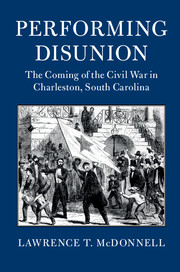14 - The Measure of a Man
from CONTRADICTIONS: STAND NOBLY TOGETHER
Published online by Cambridge University Press: 08 June 2018
Summary
Moving through Charleston's streets in 1860, the hats men met demanded that they confront questions of difference, division, stratification, and conflict. For as much as they prized distinction, rank, and order, elite and minor Charlestonians dreaded the disunity that seemed to follow in their train. More than this, they feared that, however successful their efforts to overcome internal divisions, there was a species of trickery specially thriving in hats – that odd conjuncture of play, theater, commerce, and subversion that Walter Steele's ad described.
The sheer variety of headgear one encountered passing along Broad or Church – occupational, politico- military, associational, fashion- conscious, class- demonstrative, and more – signaled how plagued with divisions civic life had become. In the comic theater of the day, “chapeaugraphers” entertained audiences by mashing a felt circle into various hat shapes and transforming their features and behavior to mimic stereotyped wearers. That mocking species of hat play was two centuries old, building from a subversive charlatan whose skill at shifting personal style to fit the hat he wore electrified seventeenth- century Paris. Popular success transformed the wooden sword Tabarin wore into a seigneur's blade, proving the point of his commedia dell'arte exactly: character was in no way fixed, honor could be bought and sold, identity was malleable, multiple, usually misapprehended. The hat made the man, audiences roared, hailing the glorious transformation of character and destiny both.
The lesson of that performance was instantly obvious to anyone strolling Charleston's streets of a late afternoon. The slave who doffed his stocking cap before the seat of power or went about bareheaded, the printer who passed down Meeting with a rectangle of newsprint atop his head, the sailor or drayman who worked the wharves of East Bay under a broad- brimmed straw hat, or the factory hand trudging back from the railroad shops north of Calhoun, a laborer's cap pulled low upon his brow – each silently declared who he was, admitted where he ranked within the social order. Likewise, the banker with an old- fashioned beaver, the Broad Street lawyer in his stylish silk hat, or the respectable mechanic sporting an outlandish stovepipe.
- Type
- Chapter
- Information
- Performing DisunionThe Coming of the Civil War in Charleston, South Carolina, pp. 284 - 300Publisher: Cambridge University PressPrint publication year: 2018



